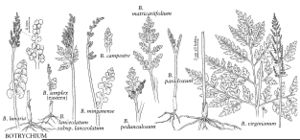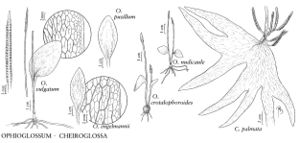Difference between revisions of "Ophioglossaceae"
FNA>Volume Importer |
TammyCharron (talk | contribs) |
||
| (8 intermediate revisions by 2 users not shown) | |||
| Line 13: | Line 13: | ||
}}<!-- | }}<!-- | ||
| − | --><span class="statement" id="st- | + | --><span class="statement" id="st-undefined" data-properties=""><b>Plants </b>perennials, terrestrial or epiphytic. <b>Roots</b> lacking root hairs, unbranched or with a few narrow lateral branches, in 1 species dichotomously branched. <b>Stems</b> simple, unbranched, upright, with eustelic vascular tissue. <b>Leaf</b> bases dilated, clasping, forming sheath, open or fused, surrounding successive leaf primordia; primordia glabrous or with long, uniseriate hairs. <b>Leaves</b> 1(–2) per stem, with common stalk divided into sterile, laminate, photosynthetic portion (trophophore) and fertile, spore-bearing portion (sporophore). <b>Trophophore</b> blades compound to simple, rarely absent, veins anastomosing or free, pinnate, or arranged like ribs of fan. <b>Indument</b> absent or of widely scattered, long, uniseriate hairs, especially on petioles and rachises. <b>Sporophores</b> pinnately branched or simple. <b>Sporangia</b> exposed or embedded, 0.5–1.5 mm diam., thick-walled, with thousands of spores. <b>Spores</b> all 1 kind, trilete, thick-walled, surface rugate, tuberculate, baculate (with projecting rods usually higher than wide), sometimes joined in delicate network, mostly with ± warty surface. <b>Gametophytes</b> not green, usually fleshy, round or linear, subterranean, mycorrhizal.</span><!-- |
-->{{Treatment/Body | -->{{Treatment/Body | ||
| Line 50: | Line 50: | ||
-->{{#Taxon: | -->{{#Taxon: | ||
name=Ophioglossaceae | name=Ophioglossaceae | ||
| − | |author=Warren H. Wagner Jr. ; Florence S. Wagner | + | |author=Warren H. Wagner Jr.;Florence S. Wagner |
|authority=Agardh | |authority=Agardh | ||
|rank=family | |rank=family | ||
| Line 57: | Line 57: | ||
|basionyms= | |basionyms= | ||
|family=Ophioglossaceae | |family=Ophioglossaceae | ||
| − | |illustrator= | + | |illustrator=Bobbi Angell |
| + | |illustration copyright=Flora of North America Association | ||
|distribution=Nearly worldwide. | |distribution=Nearly worldwide. | ||
|reference=None | |reference=None | ||
| Line 63: | Line 64: | ||
|publication year= | |publication year= | ||
|special status= | |special status= | ||
| − | |source xml=https:// | + | |source xml=https://bitbucket.org/aafc-mbb/fna-data-curation/src/2e0870ddd59836b60bcf96646a41e87ea5a5943a/coarse_grained_fna_xml/V2/V2_345.xml |
| − | |||
| − | |||
| − | |||
| − | |||
| − | |||
| − | |||
| − | |||
| − | |||
| − | |||
| − | |||
| − | |||
| − | |||
| − | |||
| − | |||
| − | |||
| − | |||
| − | |||
| − | |||
| − | |||
| − | |||
| − | |||
| − | |||
| − | |||
| − | |||
| − | |||
| − | |||
| − | |||
| − | |||
| − | |||
| − | |||
| − | |||
| − | |||
| − | |||
| − | |||
| − | |||
| − | |||
| − | |||
| − | |||
| − | |||
| − | |||
| − | |||
| − | |||
| − | |||
| − | |||
| − | |||
| − | |||
| − | |||
| − | |||
| − | |||
| − | |||
| − | |||
| − | |||
}}<!-- | }}<!-- | ||
-->[[Category:Treatment]] | -->[[Category:Treatment]] | ||
Latest revision as of 16:48, 15 June 2022
Plants perennials, terrestrial or epiphytic. Roots lacking root hairs, unbranched or with a few narrow lateral branches, in 1 species dichotomously branched. Stems simple, unbranched, upright, with eustelic vascular tissue. Leaf bases dilated, clasping, forming sheath, open or fused, surrounding successive leaf primordia; primordia glabrous or with long, uniseriate hairs. Leaves 1(–2) per stem, with common stalk divided into sterile, laminate, photosynthetic portion (trophophore) and fertile, spore-bearing portion (sporophore). Trophophore blades compound to simple, rarely absent, veins anastomosing or free, pinnate, or arranged like ribs of fan. Indument absent or of widely scattered, long, uniseriate hairs, especially on petioles and rachises. Sporophores pinnately branched or simple. Sporangia exposed or embedded, 0.5–1.5 mm diam., thick-walled, with thousands of spores. Spores all 1 kind, trilete, thick-walled, surface rugate, tuberculate, baculate (with projecting rods usually higher than wide), sometimes joined in delicate network, mostly with ± warty surface. Gametophytes not green, usually fleshy, round or linear, subterranean, mycorrhizal.
Distribution
Nearly worldwide.
Discussion
Ophioglossaceae comprise two clearly defined subfamilies, Botrychioideae and Ophioglossoideae, which are sometimes recognized as distinct families. Ophioglossaceae may be only distantly related to the ferns and more closely related to Marattiales and certain seedplants, especially Cycadales, in such characteristics as stelar type, cork cambium, dilated leaf bases, conduplicate vernation, intercalary leaf growth, collateral leaf traces, circular-bordered pits, eusporangia, massive gametophytes, sunken archegonia, and presence in some species of endoscopic embryos.
(Key to genera of Ophioglossaceae)
Genera 5, species ca. 70–80 (3 genera, 38 species in the flora).
Selected References
None.
Lower Taxa
Illustrations
Key
| 1 | Blades mostly pinnately divided or lobed; veins free; margins entire to dentate to lacerate; sporangial clusters pinnately branched, sporangia sessile or terminating short stalks. | Botrychium |
| 1 | Blades undivided or palmately lobed; veins anastomosing; margins entire; sporangial clusters with sporangia embedded in compact linear spike. | > 2 |
| 2 | Trophophore blades simple, unlobed, to 4.5 cm wide; main areoles mostly less than 6 mm wide; sporophore 1 per leaf at ground level or above ground level, or absent; plants terrestrial. | Ophioglossum |
| 2 | Trophophore blades palmately lobed, to 30 cm wide; main areoles large, mostly more than 30 mm; sporophores several to many per leaf at base of blade; plants epiphytic. | Cheiroglossa |


